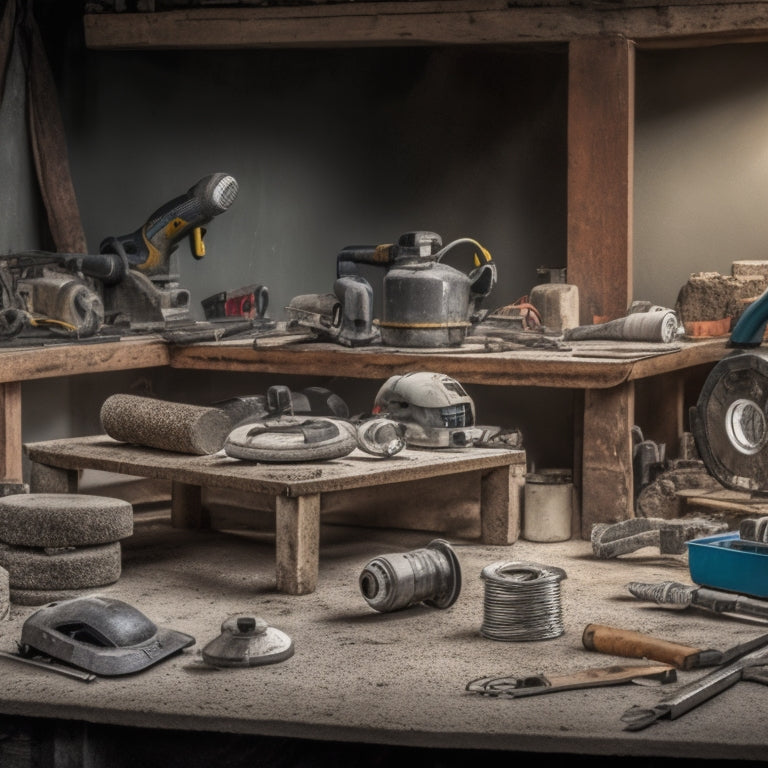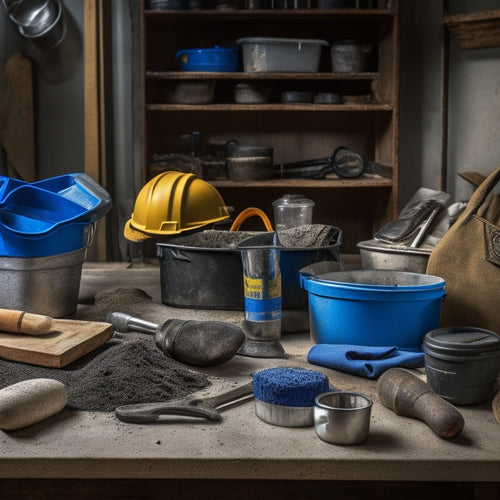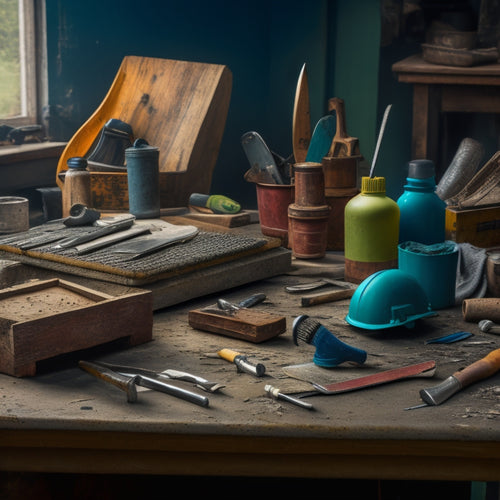
7 Must-Have Concrete Cutting Tools for Beginners
Share
As a beginner in concrete cutting, you'll need to equip yourself with the right tools for efficient and safe project execution. Start with high-quality diamond blades, robust concrete saws, and precise block chisels for accurate cuts. Versatile demolition hammers and reliable safety goggles are also non-negotiable. Don't forget efficient dust control systems to minimize respiratory risks and handy concrete trowels for finishing tasks. By investing in these 7 must-have tools, you'll be well on your way to tackling concrete cutting projects with confidence - and as you explore each tool in more detail, you'll unveil even more secrets to achieving professional-level results.
Key Takeaways
• Diamond blades are essential for precise concrete cuts, with various types suited for different tasks and materials.
• Concrete saws should have robust motors, high torque, and adjustable speed settings for versatility and effectiveness.
• Chisels and hammers are necessary for breaking and removing concrete, with block chisels and demolition hammers being essential tools.
• Safety goggles with polycarbonate or Trivex lenses, flexible frames, and ANSI Z87.1 compliance are crucial for protecting eyes from debris.
• Dust control methods, including water-based systems and vacuum attachments, are vital for minimizing airborne particles and improving visibility.
Essential Diamond Blades
You'll need high-quality diamond blades to make precise cuts in concrete, and selecting the right ones is vital for ideal performance and safety. Don't worry, we've taken care of you!
There are several diamond blade types, each designed for specific concrete cutting tasks. Turbo blades are perfect for general-purpose cutting, while segmented blades are better for aggressive cutting and demolition work. You'll also find continuous rim blades for smooth, precise cuts and asphalt blades for, you guessed it, asphalt cutting.
Proper blade maintenance is essential to extend their lifespan and prevent accidents. Regularly inspect your blades for wear and damage, and clean them with a wire brush to remove debris. Store them in a dry place, away from direct sunlight, and avoid exposing them to extreme temperatures.
Powerful Concrete Saws
With your diamond blades ready for action, it's time to pair them with a powerful concrete saw that can handle the toughest cutting tasks.
You'll want a saw that can keep up with your cutting techniques, whether you're making precise cuts or ripping through thick slabs. Look for a saw with a robust motor, high torque, and adjustable speed settings to tackle various projects.
Don't forget about saw maintenance – a well-maintained saw is a safe and efficient saw. Regularly clean and lubricate the saw, and keep the blades sharp to prevent overheating and wear.
When choosing a concrete saw, consider the type of projects you'll be working on most often. Will you be cutting through thick foundation walls or slicing through decorative pavers? Different saws are designed for specific tasks, so make sure you pick one that fits your needs.
Some popular types of concrete saws include walk-behind saws, handheld saws, and circular saws. Whichever you choose, remember to always follow safety guidelines and take regular breaks to avoid fatigue.
With the right saw and a bit of practice, you'll be cutting like a pro in no time!
Precise Block Chisels
When you're working with precise block chisels, you'll need to focus on two critical aspects: selecting the right chisel blade for the job and controlling the strike force.
You'll want to choose a blade that's specifically designed for the type of concrete you're working with, and consider factors like its width, thickness, and material.
Chisel Blade Selection
Your precise block chisel selection hinges on choosing the right blade style, which depends on the type of concrete you're cutting and the desired level of precision. Don't worry, we've got you sorted!
For beginners, it's vital to understand that different blade styles cater to specific concrete types. For instance, a pointed blade is perfect for cutting through reinforced concrete, while a flat blade is better suited for aggregate-based concrete.
When it comes to chisel techniques, remember to always maintain a consistent angle and apply gentle to moderate pressure. This will help prevent blade damage and guarantee a clean cut.
Speaking of blade maintenance, regular sharpening and cleaning are significant to extend the lifespan of your chisel blades. A dull blade can lead to uneven cuts and more effort required, so make it a habit to inspect and maintain your blades regularly.
Strike Force Control
You'll achieve unparalleled precision with strike force control precise block chisels, which utilize a calibrated striking system to deliver consistent, controlled blows. This means you can master even the most intricate cutting techniques with ease. The secret lies in the chisel's ability to regulate the force of each strike, allowing you to make precise cuts without applying too much pressure. This not only reduces fatigue but also minimizes the risk of damage to the tool or the material being cut.
To get the most out of your strike force control chisels, it's crucial to prioritize tool maintenance. Regularly clean and inspect your chisels to guarantee they remain in top condition. A well-maintained chisel will continue to deliver accurate, controlled blows, making it easier to achieve professional-looking results.
Versatile Demolition Hammers
When you're working with versatile demolition hammers, you'll need to contemplate the right attachments and bits to get the job done efficiently.
You'll want to explore the options for hammer drill attachments that can tackle various tasks, from breaking up concrete to chiseling through rebar.
Hammer Drill Attachments
With their robust construction and versatile functionality, hammer drill attachments are fundamentally versatile demolition hammers that can tackle a wide range of concrete cutting tasks.
As a beginner, you'll be thrilled to know that these attachments can transform your ordinary drill into a concrete-cutting machine. You can choose from various hammer drill types, such as rotary hammers, demolition hammers, and breaker hammers, each designed for specific tasks.
To get the most out of your hammer drill attachment, it's essential to master ideal drilling techniques. This includes maintaining a steady grip, applying gentle to moderate pressure, and keeping the drill bit perpendicular to the concrete surface.
Remember, the key to successful concrete cutting is to avoid applying too much pressure, which can damage the drill or the attachment.
Bit Selection Guide
Selecting the right drill bit is essential to achieving ideal results and prolonging the lifespan of your hammer drill attachment. Different bits are designed to handle specific concrete cutting tasks and materials. You don't want to be stuck with a bit that's as useful as a chocolate teapot, do you? So, let's get bit-savvy!
There are several bit types to choose from, including carbide-tipped, diamond-coated, and abrasive bits. Carbide-tipped bits are perfect for drilling through concrete with rebar, while diamond-coated bits are ideal for heavy-duty demolition work. Abrasive bits, on the other hand, are great for scraping and removing old adhesives.
Proper bit maintenance is also essential. Regularly clean and inspect your bits for wear and tear, and store them in a dry place to prevent rust. You should also consider having a spare bit on hand, just in case your primary one decides to take an unexpected siesta.
Reliable Safety Goggles
Protecting your eyes from debris and dust becomes a top priority when operating concrete cutting tools, and you'll need reliable safety goggles that provide a secure, comfortable fit. You don't want to be that guy who's trying to get the job done with one eye closed, squinting through a cloud of dust. Not only is it annoying, but it's also a serious safety hazard.
When choosing the right safety goggles, look for the following key features:
-
Lens material: Opt for polycarbonate or Trivex lenses that provide excellent impact resistance and optical clarity.
-
Frame design: Select goggles with a flexible, rubberized frame that fits snugly around your face, guaranteeing a comfortable and secure fit.
-
Safety standards: Make sure your goggles meet or exceed ANSI Z87.1 safety standards, which guarantee protection against high-velocity impacts.
Efficient Dust Control Systems
Controlling dust generation is essential when operating concrete cutting tools, as it not only improves visibility but also reduces the risk of respiratory problems and equipment damage. You don't want to be stuck in a cloud of concrete dust, wondering what just hit you (literally!). That's why you need to get familiar with efficient dust control systems.
When it comes to dust suppression techniques, you've got a few options. You can opt for a water-based system, which uses a fine mist to keep dust particles at bay. Or, you can go for a dry dust collection system, which uses air filtration to capture particles. Both methods are effective, but you'll want to take into account factors like workspace size, airflow, and moisture levels when choosing the best approach.
Don't forget about vacuum attachment options! These handy add-ons can be attached to your concrete cutter, allowing you to suck up dust and debris as you work. It's like having your own personal dust-busting sidekick.
Handy Concrete Trowels
You'll reach for your trusty concrete trowel more often than you think, as this versatile hand tool is perfect for applying, smoothing, and finishing concrete surfaces.
It's like having a magic wand for concrete - wave it around, and voilà! Your concrete looks amazing. But, of course, it's not magic; it's all about mastering the right trowel techniques.
There are several trowel types to choose from, each designed for specific tasks. Here are three essential ones to get you started:
-
Finishing Trowel: Ideal for applying thin layers of concrete and achieving a smooth finish.
-
Pooling Trowel: Perfect for spreading and leveling large areas of concrete, especially when working with self-leveling compounds.
-
Notched Trowel: Great for applying thick layers of concrete and creating textured surfaces.
Frequently Asked Questions
Can I Use a Concrete Cutting Tool for Asphalt or Brick as Well?
You're wondering if you can use your trusty concrete cutting tool for asphalt or brick, right?
Well, let's get real - concrete cutting tools are designed for, you guessed it, concrete!
While they might seem similar, asphalt and brick require specialized blades and techniques.
Don't risk damaging your tool or the material.
Instead, invest in an asphalt cutting tool or a brick cutting tool specifically designed for the job.
Your tools (and the materials) will thank you!
How Do I Maintain and Sharpen My Concrete Cutting Tools?
Time to get down to business and keep your concrete cutting tools in top shape!
You'll want to prioritize tool maintenance to avoid dull blades and reduced efficiency.
For sharpening techniques, start with a diamond stone or a file to remove metal residue. Then, use a honing compound to polish the edge.
Don't forget to clean and store your tools properly to prevent rust.
With regular TLC, your tools will be cutting like new in no time!
Are There Any Specific Storage Requirements for Concrete Cutting Tools?
You're probably thinking, 'Do I really need to baby my concrete cutting tools?' And the answer is, absolutely!
Proper storage is essential to maintaining tool safety. You see, storing your tools in a dry, cool place with minimal exposure to moisture and extreme temperatures can greatly extend their lifespan.
So, make sure to keep them away from direct sunlight, avoid humid environments, and store them in a protective case or toolbox to prevent damage.
Trust us, your tools (and your wallet) will thank you!
Can I Use Concrete Cutting Tools in Areas With Limited Ventilation?
When you're planning to cut concrete in areas with limited ventilation, you're playing with fire - or rather, dust.
Don't risk inhaling silica particles or creating a cloud of chaos.
Take safety precautions seriously and prioritize dust control.
Wear a respirator, guarantee good airflow, and use tools with built-in dust suppression or vacuum attachments.
Don't let your project turn into a hazardous mess - breathe easy and cut smart!
Are There Any Alternative Tools for Concrete Cutting for Small Projects?
You're wondering if you're stuck with the usual suspects for small concrete projects, aren't you? Well, breathe easy! There are alternative tools that'll get the job done without breaking the bank.
Handheld saws, for instance, are perfect for smaller cuts and offer more control.
And, let's not forget diamond blades - they're a game-changer for precision cutting. You'll be slicing through concrete like a pro in no time!
Conclusion
You've made it this far, and now you're equipped with the essential concrete cutting tools for beginners.
Remember, investing in quality tools is vital for efficiency, safety, and precision.
With these must-haves, you'll be well on your way to tackling concrete cutting projects like a pro.
Practice makes perfect, so get out there and start cutting!
Related Posts
-

5 Tools Needed for Quick Fix Concrete Mixing
You'll need five essential tools to tackle a quick fix concrete mixing project efficiently. First, you'll require a s...
-

Must-Have Handheld Tools for Concrete Repair
When tackling a concrete repair project, it is crucial to have the right handheld tools to achieve a professional fin...
-

Why You Need These Concrete Overlay Tools
When tackling a concrete overlay project, you need the right tools to achieve a flawless finish and avoid costly mist...


